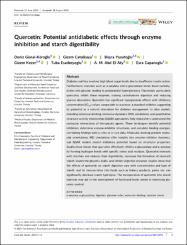| dc.contributor.author | Günal-Köroğlu, Deniz | |
| dc.contributor.author | Catalkaya, Gizem | |
| dc.contributor.author | Yusufoğlu, Büşra | |
| dc.contributor.author | Kezer, Gizem | |
| dc.contributor.author | Esatbeyoglu, Tuba | |
| dc.contributor.author | Abd El-Aty A.M. | |
| dc.contributor.author | Capanoglu, Esra | |
| dc.date.accessioned | 2024-10-24T07:13:13Z | |
| dc.date.available | 2024-10-24T07:13:13Z | |
| dc.date.issued | 2024 | en_US |
| dc.identifier.citation | Günal‐Köroğlu, D., Catalkaya, G., Yusufoğlu, B., Kezer, G., Esatbeyoglu, T., Abd El‐Aty, A. M., & Capanoglu, E. (2024). Quercetin: Potential antidiabetic effects through enzyme inhibition and starch digestibility. Food Safety and Health. | en_US |
| dc.identifier.issn | 28351096 | |
| dc.identifier.uri | https://doi.org/10.1002/fsh3.12066 | |
| dc.identifier.uri | https://hdl.handle.net/20.500.12513/6957 | |
| dc.description.abstract | Diabetes mellitus involves high blood sugar levels due to insufficient insulin action. Furthermore, enzymes such as α-amylase and α-glucosidase break down carbohydrates into glucose, leading to postprandial hyperglycemia. Flavonoids, particularly quercetin, inhibit these enzymes, slowing carbohydrate digestion and reducing glucose absorption. Quercetin has significant hypoglycemic effects with inhibitory concentration (IC50) values comparable to acarbose, a standard inhibitor, suggesting its potential as a natural alternative for diabetes management. In silico models, including molecular docking, molecular dynamics (MD) simulations, and quantitative structure-activity relationship (QSAR) approaches, help researchers understand the molecular interactions of therapeutic agents. These techniques identify potential inhibitors, determine enzyme-inhibitor structures, and calculate binding energies, correlating findings with in vitro or in vivo data. Molecular docking predicts molecular orientations, MD simulations offer insights into enzyme–inhibitor dynamics, and QSAR models predict inhibitory potential based on structural properties. Studies have shown that quercetin effectively inhibits α-glucosidase and α-amylase by forming hydrogen bonds with specific amino acid residues. Quercetin interacts with starches and reduces their digestibility, increases the formation of resistant starch, lowers the glycemic index, and inhibits digestive enzymes. Studies show that the effects of quercetin on starch digestion vary with concentration and type of starch, and its incorporation into foods such as bakery products, pasta, etc. can significantly decrease starch hydrolysis. The incorporation of quercetin into starch matrices may aid in the development of functional foods aimed at improving glycemic control. © 2024 The Author(s). Food Safety and Health published by John Wiley & Sons Australia, Ltd on behalf of International Association of Dietetic Nutrition and Safety. | en_US |
| dc.language.iso | eng | en_US |
| dc.publisher | John Wiley and Sons Inc | en_US |
| dc.relation.isversionof | 10.1002/fsh3.12066 | en_US |
| dc.rights | info:eu-repo/semantics/openAccess | en_US |
| dc.subject | digestion | en_US |
| dc.subject | glycemic index | en_US |
| dc.subject | molecular docking | en_US |
| dc.subject | resistant starch | en_US |
| dc.subject | α-amylase | en_US |
| dc.subject | α-glucosidase | en_US |
| dc.title | Quercetin: Potential antidiabetic effects through enzyme inhibition and starch digestibility | en_US |
| dc.type | other | en_US |
| dc.relation.journal | Food Safety and Health | en_US |
| dc.contributor.department | Ziraat Fakültesi | en_US |
| dc.contributor.authorID | Gizem Kezer / 0000-0003-1530-3664 | en_US |
| dc.relation.publicationcategory | Diğer | en_US |


















